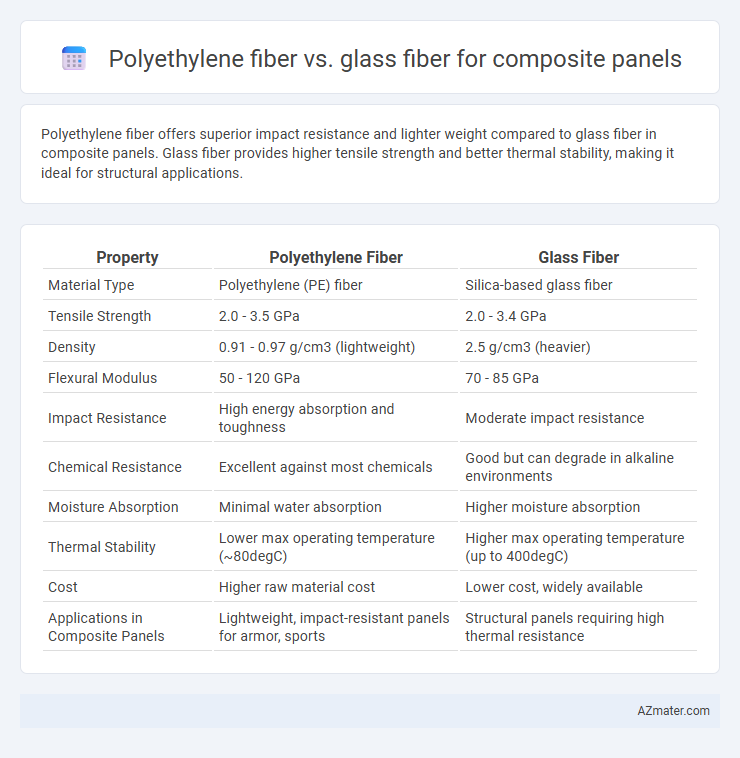Polyethylene fiber offers superior impact resistance and lighter weight compared to glass fiber in composite panels. Glass fiber provides higher tensile strength and better thermal stability, making it ideal for structural applications.
Table of Comparison
| Property | Polyethylene Fiber | Glass Fiber |
|---|---|---|
| Material Type | Polyethylene (PE) fiber | Silica-based glass fiber |
| Tensile Strength | 2.0 - 3.5 GPa | 2.0 - 3.4 GPa |
| Density | 0.91 - 0.97 g/cm3 (lightweight) | 2.5 g/cm3 (heavier) |
| Flexural Modulus | 50 - 120 GPa | 70 - 85 GPa |
| Impact Resistance | High energy absorption and toughness | Moderate impact resistance |
| Chemical Resistance | Excellent against most chemicals | Good but can degrade in alkaline environments |
| Moisture Absorption | Minimal water absorption | Higher moisture absorption |
| Thermal Stability | Lower max operating temperature (~80degC) | Higher max operating temperature (up to 400degC) |
| Cost | Higher raw material cost | Lower cost, widely available |
| Applications in Composite Panels | Lightweight, impact-resistant panels for armor, sports | Structural panels requiring high thermal resistance |
Introduction to Composite Panel Materials
Polyethylene fiber and glass fiber are widely used reinforcement materials in composite panels, each offering distinct mechanical properties and application benefits. Polyethylene fiber is known for its high tensile strength, lightweight, and excellent impact resistance, making it suitable for applications requiring flexibility and durability, while glass fiber provides superior stiffness, thermal stability, and cost-effectiveness. The choice between polyethylene fiber and glass fiber in composite panels depends on factors such as load-bearing requirements, environmental conditions, and manufacturing processes.
Overview of Polyethylene Fiber
Polyethylene fiber, known for its exceptional tensile strength and lightweight properties, offers superior impact resistance and flexibility compared to glass fiber in composite panels. Its high moisture resistance and chemical inertness make it ideal for applications requiring durability in harsh environments. These fibers also provide enhanced fatigue resistance and better energy absorption, improving the overall performance and longevity of composite structures.
Overview of Glass Fiber
Glass fiber, a widely used reinforcement in composite panels, offers high tensile strength, excellent chemical resistance, and superior thermal stability compared to polyethylene fiber. Its inorganic nature provides enhanced durability and dimensional stability under varying environmental conditions. Commonly used in aerospace, automotive, and construction industries, glass fiber composites deliver a cost-effective balance of mechanical performance and weight reduction.
Mechanical Properties Comparison
Polyethylene fiber exhibits high tensile strength and exceptional impact resistance, making it ideal for lightweight composite panels that require toughness and flexibility. Glass fiber offers superior stiffness, high tensile modulus, and excellent dimensional stability, which enhances the rigidity and load-bearing capacity of composite panels. For applications demanding mechanical durability with weight savings, polyethylene fiber composites excel, while glass fiber composites are preferred for structural strength and rigidity in engineering designs.
Weight and Density Differences
Polyethylene fiber offers a significantly lower density, typically around 0.93-0.97 g/cm3, compared to glass fiber's density of approximately 2.5 g/cm3, resulting in much lighter composite panels. This weight advantage makes polyethylene fiber composites ideal for applications demanding reduced mass without compromising structural integrity. Glass fiber, while heavier, provides higher rigidity and thermal resistance, but polyethylene fiber's lightweight nature enhances overall panel portability and ease of installation.
Durability and Environmental Resistance
Polyethylene fiber exhibits superior durability in composite panels due to its high impact resistance, excellent fatigue performance, and resistance to moisture absorption. Glass fiber offers strong mechanical strength but is more susceptible to environmental factors like UV degradation, moisture ingress, and alkali attack, which can reduce long-term durability. In harsh environmental conditions, polyethylene fiber composites outperform glass fiber by maintaining structural integrity and resisting chemical and weathering effects more effectively.
Cost Analysis and Market Availability
Polyethylene fiber composites generally offer lower production costs due to cheaper raw materials and simpler manufacturing processes compared to glass fiber composites, which involve higher energy consumption and material expenses. Market availability favors glass fiber as it is widely produced globally, offering diverse form factors and suppliers, whereas polyethylene fiber composites remain niche with limited suppliers primarily focused on high-performance applications. Cost-performance balance in composite panels often depends on application-specific requirements, with polyethylene fibers preferred for lightweight, impact-resistant solutions and glass fibers favored for stiffness and thermal stability.
Ease of Manufacturing and Processing
Polyethylene fiber offers superior ease of manufacturing and processing for composite panels due to its low density, flexibility, and thermal stability, allowing faster molding and reduced cycle times. Glass fiber, while providing high strength and stiffness, requires more energy-intensive processes and careful handling due to its brittleness and heavier weight. The adaptability of polyethylene fiber to automated layup and filament winding methods enhances production efficiency compared to the more rigid glass fiber reinforcement.
Application Suitability in Various Industries
Polyethylene fiber offers exceptional impact resistance and lightweight properties, making it ideal for composite panels used in automotive and sports equipment industries where flexibility and durability are critical. Glass fiber exhibits superior tensile strength and thermal resistance, which suits construction, aerospace, and marine sectors requiring rigid, high-performance composite panels. Selection depends on industry-specific demands for strength, weight, and environmental resistance in composite panel applications.
Future Trends in Composite Panel Materials
Polyethylene fiber offers lightweight durability and excellent impact resistance, driving its increased use in composite panels for automotive and aerospace industries seeking efficiency and sustainability. Glass fiber remains prevalent due to its cost-effectiveness and high tensile strength, but innovations in hybrid composites combining polyethylene and glass fibers are emerging to enhance mechanical performance and corrosion resistance. Future trends emphasize the development of bio-based polyethylene fibers and nanoscale glass fiber reinforcements to improve environmental compatibility and multifunctional properties in composite panels.

Infographic: Polyethylene fiber vs Glass fiber for Composite panel
 azmater.com
azmater.com